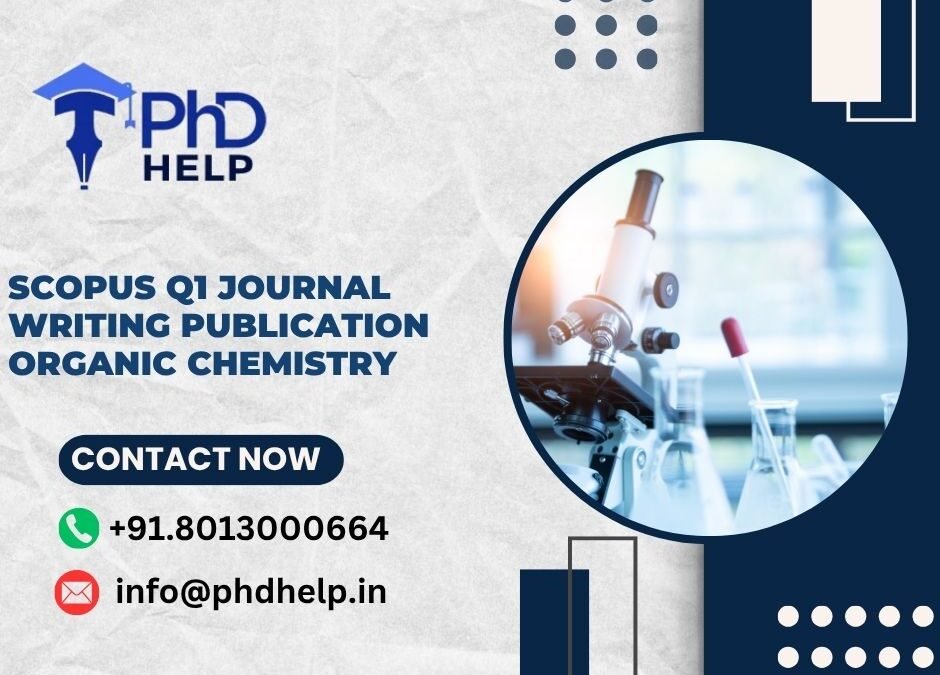SCOPUS Q1 journal writing publication Organic Chemistry
SCOPUS Q1 journal writing publication Organic Chemistry. Publishing in a SCOPUS Q1 journal in Organic Chemistry is the pinnacle of success for researchers exploring the structure, properties, synthesis, and reactivity of organic compounds. The field of Organic Chemistry drives innovation in pharmaceuticals, materials science, and industrial chemistry. Securing a publication in a Q1-ranked SCOPUS journal not only establishes credibility in the global scientific community but also ensures your work contributes meaningfully to advancing chemical knowledge. This comprehensive guide provides detailed insights into writing, structuring, and submitting research for SCOPUS Q1 Organic Chemistry journals.
Understanding SCOPUS Q1 Journals in Organic Chemistry
SCOPUS is a globally recognized abstract and citation database that ranks journals based on parameters such as CiteScore, SNIP (Source Normalized Impact per Paper), and SJR (SCImago Journal Rank). Journals within the Q1 quartile represent the top 25% in their field, renowned for publishing high-impact, peer-reviewed research.
In Organic Chemistry, Q1 journals emphasize topics such as:
-
Synthetic Organic Chemistry and Reaction Mechanisms
-
Medicinal and Pharmaceutical Chemistry
-
Green Chemistry and Sustainable Synthesis
-
Heterocyclic and Organometallic Chemistry
-
Physical Organic Chemistry and Spectroscopy
-
Computational Chemistry and Molecular Design
Leading SCOPUS Q1 journals in this domain include Journal of Organic Chemistry, Organic Letters, Tetrahedron, Advanced Synthesis & Catalysis, and Organic & Biomolecular Chemistry.
Key Features of SCOPUS Q1 Organic Chemistry Journals
Q1 journals stand out due to their:
-
High Impact Factors: Reflecting strong influence and citation performance.
-
Rigorous Peer Review: Ensuring scientific precision and innovation.
-
International Scope: Encouraging global collaboration across chemical sciences.
-
Emphasis on Novelty: Publishing only unique, reproducible, and mechanistically insightful studies.
-
Interdisciplinary Relevance: Connecting Organic Chemistry to material science, biochemistry, and nanotechnology.
Publishing in these journals demonstrates mastery over experimental design and contribution to modern chemical innovation.
Selecting the Right SCOPUS Q1 Journal for Your Research
Selecting the best journal requires strategic consideration. Before submission, evaluate:
-
Relevance of Research Scope: Match your study’s focus—synthesis, catalysis, or computational modeling—to the journal’s aims.
-
CiteScore and Impact Metrics: Analyze performance indicators to determine prestige and readership.
-
Open Access or Subscription: Decide based on visibility goals and funding availability.
-
Acceptance Rate and Review Period: Some journals are highly selective with longer review durations.
-
Author Guidelines: Review formatting, referencing, and submission checklists carefully.
Choosing the correct journal enhances publication efficiency and increases acceptance chances.
Steps for Writing a SCOPUS Q1 Organic Chemistry Manuscript
A manuscript suitable for a Q1 Organic Chemistry journal requires precision, clarity, and scientific innovation.
1. Title and Abstract Crafting
Create a concise, descriptive, and keyword-optimized title reflecting your research.
Example: “Efficient Metal-Free Catalytic Pathway for the Synthesis of Nitrogen Heterocycles under Green Conditions.”
Your abstract should provide a clear overview of objectives, experimental approach, major findings, and implications. Use measurable results and specific reaction outcomes.
2. Introduction: Establishing Scientific Context
Highlight the research gap, explain the chemical problem, and state how your study advances organic synthesis or mechanistic understanding. Reference recent publications from Q1 journals to position your research within current trends.
3. Experimental Section: Detailing Methods
Organic Chemistry demands precise methodological documentation. Include:
-
Reaction Conditions: Reagent purity, temperature, catalysts, solvents.
-
Analytical Techniques: NMR, IR, Mass Spectrometry, X-ray Crystallography, or HPLC for product characterization.
-
Yield Optimization: Detail variations tested to achieve maximum efficiency.
Transparency ensures reproducibility—a key requirement for SCOPUS Q1 journals.
4. Results and Discussion: Presenting Insights
Present results systematically through schemes, reaction tables, and mechanistic pathways. Discuss:
-
Reaction yields and selectivity
-
Catalyst efficiency and kinetics
-
Environmental sustainability of your process
-
Theoretical support from computational chemistry (if applicable)
Integrate findings with established chemical theories and explain how they contribute to the field.
5. Conclusion: Summarizing the Impact
Conclude with the key takeaways—highlighting novelty, industrial relevance, and potential for future research. Avoid redundancy but emphasize your contribution’s significance.
Data Representation and Visualization in Organic Chemistry
Data visualization is a hallmark of top-tier Organic Chemistry papers. Use clear and professional chemical structures, reaction schemes, and spectral data. Tools such as ChemDraw, Origin, and Gaussian are essential for graphical accuracy.
Visual clarity enhances comprehension and helps reviewers quickly grasp your findings. Ensure that each figure and table includes appropriate captions and is referenced in the text.
Ensuring Scientific Integrity and Ethical Compliance
Maintaining ethical standards is mandatory for SCOPUS Q1 publication. Follow these principles:
-
Zero Plagiarism: Always use plagiarism detection tools before submission.
-
Accurate Data Reporting: Do not manipulate spectra, yields, or images.
-
Proper Authorship Attribution: List all contributors transparently.
-
Conflict of Interest Disclosure: Clearly state any funding or affiliations.
-
Adherence to COPE Guidelines: Ensure compliance with the Committee on Publication Ethics.
Ethical transparency builds trust and ensures long-term credibility in the scientific community.
Peer Review Process: Navigating Evaluation and Revision
After submission, your manuscript undergoes a rigorous peer review process. Reviewers assess the novelty, reproducibility, and scientific depth of your work. To handle the process effectively:
-
Address reviewer comments point-by-point with detailed explanations.
-
Update figures, schemes, and references as required.
-
Maintain a professional tone throughout your response.
-
Use “track changes” to show modifications clearly.
Constructive engagement with reviewers often transforms an initial rejection into successful publication.
Citations and References in Organic Chemistry Publications
Accurate referencing demonstrates scholarly depth. Q1 journals typically use ACS (American Chemical Society) or Harvard styles. Cite recent and relevant research to establish your work’s scientific context.
Use reference management tools such as EndNote, Mendeley, or Zotero to maintain consistency. Avoid over-citation of non-peer-reviewed sources or predatory journals.
A well-referenced paper strengthens credibility and supports higher citation rates post-publication.
Post-Publication Impact and Visibility Enhancement
After publication, maximizing your research visibility is vital for academic recognition. You can:
-
Share your publication on ResearchGate, LinkedIn, and institutional websites.
-
Present findings at international Organic Chemistry conferences.
-
Engage with online academic communities to discuss your work.
-
Optimize metadata and abstracts using relevant SEO keywords.
-
Track your paper’s citations via Scopus metrics and Altmetric data.
Consistent post-publication engagement boosts impact and establishes your reputation as a thought leader in Organic Chemistry.
Professional Support for SCOPUS Q1 Organic Chemistry Publication
Many researchers benefit from expert assistance in the publication process. Professional services offer:
-
Scientific editing and proofreading to refine technical language.
-
Formatting and citation standardization as per Q1 journal templates.
-
Plagiarism screening and data verification.
-
Journal selection and submission management.
-
Response letter preparation for peer review.
Such services significantly enhance acceptance rates and streamline the entire publication journey.
Conclusion
Publishing in a SCOPUS Q1 Organic Chemistry journal demands more than strong experimental results—it requires clarity, innovation, and adherence to the highest academic standards. From designing robust methodologies to responding professionally to reviewers, every step contributes to achieving publication success.
By mastering manuscript structure, ethical compliance, and effective data presentation, researchers can transform their findings into impactful scientific contributions. In a rapidly advancing world of chemical discovery, publishing in top-ranked SCOPUS journals not only validates your research but also strengthens your position as a leader in the field of Organic Chemistry.
Thank you for read our blog “SCOPUS Q1 journal writing publication Organic Chemistry”
Also read our more BLOG here
For PhD writing help Contact: +91.8013000664 || info@phdhelp.in

